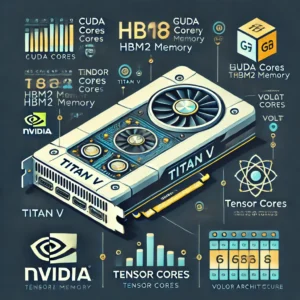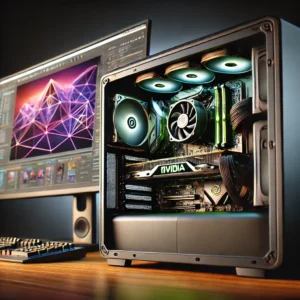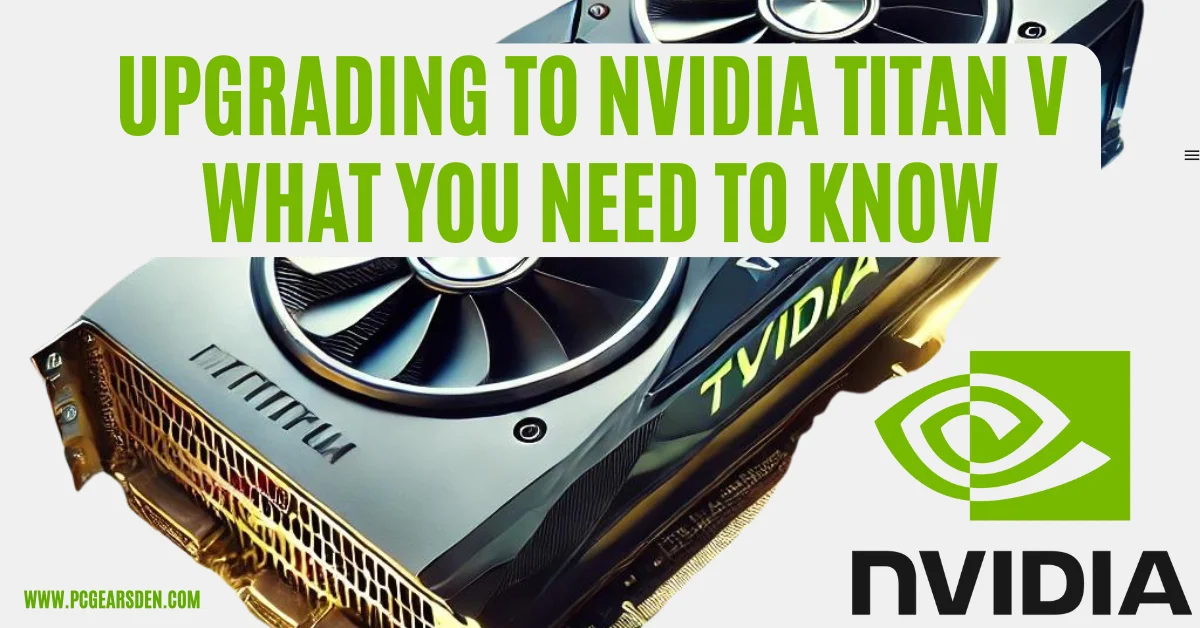In the world of GPUs, few can beat the power of Nvidia Titan V which is also reputed for its unmatched speed and leading-edge technology. If you are a data scientist, AI researcher or just a gaming fan looking for the ultimate experience then you need to consider upgrading your machine to Nvidia Titan V as it could make a significant difference. This article will therefore explore vital Nvidia Titan V features, giving you an extensive outlook on why and how to upgrade.
Nvidia Titan V is based on Nvidia’s Volta architecture and was issued to the public in December 2017. Most importantly, it is designed to provide unmatched performance especially in scientific simulations, deep learning and complex computing purposes. It has 21.1 billion transistors, 12GB of HBM2 memory and 5120 CUDA cores; thereby places the Titan V as one of the most powerful graphic processing units on sale.

Key Features of Nvidia Titan V
1. Volta Architecture
The Nvidia Titan V leverages the Volta architecture, which introduces Tensor Cores designed specifically for deep learning. These cores provide up to 110 teraflops of performance, significantly boosting AI and machine learning applications.
2. High Bandwidth Memory (HBM2)
The 12 GB HBM2 memory offers a memory bandwidth of 652.8 GB/s, ensuring rapid data processing and high performance in memory-intensive applications.
3. CUDA Cores
With 5120 CUDA cores, the Titan V excels in parallel processing, making it ideal for tasks that require extensive computational power, such as rendering, simulations, and complex calculations.
4. Energy Efficiency
Despite its high performance, the Titan V is designed to be energy efficient. The Volta architecture allows for better power management, providing superior performance per watt compared to previous architectures.
Key Specifications of Nvidia Titan V
To better understand the capabilities of the Nvidia Titan V, let’s look at its core specifications:
| Feature | Specification |
|---|---|
| Architecture | Volta |
| CUDA Cores | 5120 |
| Tensor Cores | 640 |
| Base Clock | 1200 MHz |
| Boost Clock | 1455 MHz |
| Memory | 12 GB HBM2 |
| Memory Bandwidth | 652.8 GB/s |
| TDP | 250W |
| Transistors | 21.1 billion |
| Price (Launch) | $2,999 USD |
Benefits of Upgrading to Nvidia Titan V
1. Superior Performance
The Nvidia Titan V delivers exceptional performance across a range of applications. For professionals in AI and deep learning, the Tensor Cores provide a significant boost, enabling faster training times and more efficient computations.
2. Enhanced Graphics and Rendering
For gamers and designers, the Titan V offers incredible graphics performance. It handles high-resolution textures, complex shaders, and realistic lighting effects with ease, providing an immersive gaming and rendering experience.
3. Future-Proofing
Upgrading to the Nvidia Titan V ensures that your system is future-proof. As applications and games become more demanding, having a powerful GPU like the Titan V will keep your system ahead of the curve.
4. Versatility
The Titan V is versatile, excelling in various domains from gaming and VR to scientific research and AI development. Its robust feature set makes it suitable for both personal and professional use.
How to Upgrade to Nvidia Titan V
1. System Compatibility
Before upgrading, ensure your system is compatible with the Nvidia Titan V. Check your motherboard for PCIe slots, power supply capacity, and physical space within your case to accommodate the GPU.
2. Installation Process
- Power Off and Unplug: Turn off your PC and unplug it from the power source.
- Remove Existing GPU: Carefully remove your existing GPU from the PCIe slot.
- Install Titan V: Insert the Nvidia Titan V into the PCIe slot and secure it in place.
- Connect Power Cables: Connect the necessary power cables from your power supply to the GPU.
- Close Case and Power On: Close your PC case, plug it back in, and power it on.
3. Driver Installation
Download and install the latest drivers from the Nvidia website to ensure optimal performance and compatibility with your system.

Performance Comparison Nvidia Titan V To Other GPUs
When comparing the Nvidia Titan V to other GPUs, such as the Nvidia GeForce GTX 1060 vs 970, the Titan V stands out significantly. Its advanced architecture, higher CUDA core count, and superior memory bandwidth make it far more capable of handling demanding tasks.
Performance Benchmarks
| Benchmark Test | Nvidia Titan V | Nvidia GTX 1080 Ti | Nvidia GTX 1060 |
|---|---|---|---|
| 3DMark Fire Strike | 34,123 | 29,850 | 12,795 |
| Unigine Superposition | 11,580 | 8,738 | 3,702 |
| AI Training Time | 2.1 hours | 3.5 hours | 6.8 hours |
| Rendering Time (Blender) | 5 minutes | 8 minutes | 15 minutes |
For more detailed specifications and comparisons, you can visit the Nvidia Titan V specifications page on TechPowerUp.
Real-World Applications Of Nvidia Titan V
1. AI and Machine Learning
The Titan V’s Tensor Cores are specifically designed for AI and machine learning applications, providing substantial improvements in training times and computational efficiency.
2. Scientific Research
Researchers benefit from the Titan V’s ability to perform complex simulations and calculations, making it ideal for fields such as computational biology, physics, and chemistry.
3. Gaming and VR
Gamers and VR enthusiasts will appreciate the Titan V’s ability to render high-resolution graphics with smooth frame rates, providing a more immersive experience.
Conclusion
Upgrading to the Nvidia Titan V is a significant step forward for anyone seeking top-tier performance in their computing tasks. Whether you’re a professional in AI research, a gamer, or a designer, the Titan V offers unparalleled capabilities that can handle the most demanding applications. With its advanced architecture, massive memory, and energy efficiency, the Nvidia Titan V is an investment in future-proofing your system and unlocking new levels of performance.
FAQs
1. What are the main benefits of upgrading to a high-performance GPU?
Upgrading to a high-performance GPU like the Nvidia Titan V provides several benefits, including enhanced computational power for demanding tasks, improved graphics rendering for gaming and design, and better energy efficiency. These GPUs are particularly beneficial for professionals in fields such as AI research, data science, and 3D modeling, where advanced processing capabilities are crucial.
2. How does a powerful GPU improve gaming and VR experiences?
A powerful GPU enhances gaming and VR experiences by providing higher frame rates, better resolution, and more detailed graphics. This results in smoother gameplay and a more immersive experience. GPUs with advanced architectures and higher memory bandwidth can handle complex shaders and realistic lighting effects more efficiently, which is essential for high-end gaming and virtual reality applications.
3. What should I consider before upgrading my graphics card?
Before upgrading your graphics card, consider compatibility with your current system, including the motherboard, power supply, and physical space within your PC case. Ensure that your system has the necessary PCIe slots and power connectors. It’s also important to check for driver support and ensure that your operating system is compatible with the new GPU.
4. Where can I find detailed specifications for high-end graphics cards?
For detailed specifications and performance benchmarks of high-end graphics cards, resources like TechPowerUp provide comprehensive information. For instance, you can find in-depth details about the Nvidia Titan V, including its architecture, CUDA cores, memory specifications, and performance benchmarks, on their website. Visit the Nvidia Titan V specifications page on TechPowerUp for more information.
